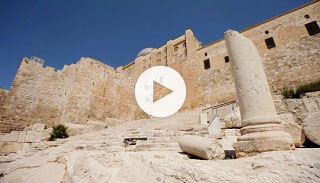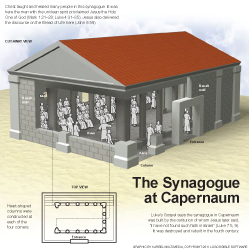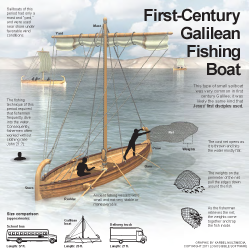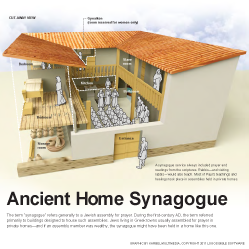4:1–11 The temptations faced by Jesus follow the same pattern as the Israelites’ disobedience in the desert. The Israelites demanded bread, doubted the Lord’s presence, and despaired of His help (compare Num 11). Jesus reverses all of these acts of faithlessness. |
4:1 was led up into the wilderness God led His people through the desert for 40 years due to their unfaithfulness (see note on Luke 4:1). The Spirit leads Jesus into the wilderness for 40 days so that His fidelity might be set in contrast to the nation’s infidelity.
might be set in contrast to the nation’s infidelity.
by the Spirit Matthew emphasizes that the Spirit leads Jesus; the devil is allowed to test Him but does not lead Him.
devil The Greek term used here, diabolos, refers to a spiritual figure who is adversarial to God and His purposes. In Mark 1:13 and Matt 4:10, this figure is referred to by the Greek term satanas (see note on Mark 1:13).
 Satan in the Old Testament and the Serpent of Genesis 3
Satan in the Old Testament and the Serpent of Genesis 3
4:2 fasted forty days and forty nights Fasting during this time period meant eating nothing at all. The text does not seem to imply that Jesus was sustained supernaturally during His fast; instead, it emphasizes that He experienced hunger. Jesus’ 40-day fast recalls Moses’ 40 days on the mountain (Exod 24:18), the Israelites’ 40 years in the desert (Num 14:33–34), and Elijah’s 40 days at Mount Horeb (1 Kgs 19:1–8).
4:3 the tempter approached and said to him The text does not say whether the devil is in human form.
If you are the Son of God The devil uses this challenge twice in his temptations of Jesus. He turns the words of Matt 3:17 into a taunt.
order that these stones become bread Parallels the Israelites’ failure in the desert. They complained that God did not provide enough food for them (Exod 16:3). The devil is tempting Jesus to break His fast, which the text implies would be equivalent to disobedience to God the Father.
4:4 It is written Jesus’ reply comes from Deut 8:3.
4:5 holy city A common term for Jerusalem.
highest point See note on Luke 4:9.
4:6 throw yourself down This test of God’s providence is far more extreme than any test Israel underwent in the desert. No biblical precedent exists for God’s choosing to save someone from falling in this way.
He will command his angels concerning you See note on Luke 4:10.
4:7 You are not to put the Lord your God to the test A quotation from Deut 6:16, which refers to the Israelites’ testing Yahweh in Exod 17:2–7.
4:8 very high mountain The location of this mountain is unknown. Matthew’s Gospel records many important events taking place on mountains—the Sermon (Matt 5:1), Jesus’ prayer (14:23), the transfiguration (17:1), and the Great Commission (28:20).
showed him all the kingdoms It is uncertain what Matthew intends to describe. The Greek word deiknymi used here means “to show or point out.” The apparent implication is that the devil simply points out the general direction of the kingdoms of the earth, naming them as he does so. Visions or physical movement may be involved, but this text does not mention such phenomena.
4:9 I will give See note on Luke 4:6.
fall down A common posture of respect and submission in the ancient Near East.
worship me The Greek word used here, proskyneō, does not necessarily refer to religious worship. It also can be used to describe the act of honoring an earthly king.
4:10 Go away, Satan Jesus later rebukes Satan’s work through Peter using a similar remark (Matt 16:23).
it is written Jesus quotes Deut 6:13, where the entire passage speaks against doubting Yahweh. Deuteronomy 6:10–11 describes how Yahweh would lead the Israelites into the promised land and provide them with an abundance of good things; Deut 6:12 warns against forgetting Yahweh. God led His people into the promised land despite the strength of its inhabitants. He also brought about the kingdom of His Messiah despite opposition.
4:11 angels came and began ministering to him Compare Luke 4:13, which strikes a more ominous tone. At Jesus’ arrest, He tells Peter that He could have angels sent to defend Him (Matt 26:53).
4:12–17 Following His temptation in the wilderness, Jesus returns to the region of Galilee and begins His ministry. This is approximately ad 28. Luke estimates that Jesus was around 30 when He began His public ministry (Luke 3:23). |
4:12 John had been arrested This statement both anchors the beginning of Jesus’ ministry in historical time and demonstrates the connection between John and Jesus. John’s ministry was decreasing, but Jesus’ was increasing (see John 3:30).
and Jesus. John’s ministry was decreasing, but Jesus’ was increasing (see John 3:30).
4:13 Capernaum A fishing village on the Sea of Galilee (see note on Luke 4:31).
Zebulun and Naphtali These tribes were allotted territory in what became known as Galilee, but the Jewish population was largely displaced during the Persian period (ca. 550–330 bc). The inhabitants of Jesus’ day were mostly Gentiles (non-Jewish people) or descendants of Jews who had resettled in the region.
4:14 spoken by the prophet Isaiah Matthew quotes Isa 9:1–2, which emphasizes an ideal king from David’s line (compare Isa 9:6 and note). By the time of Matthew’s writing, the passage had become associated with the Messiah. The phrase “for to us a child is born” follows a few verses later (Isa 9:6).
 Jesus’ Fulfillment of Old Testament Prophecy Table
Jesus’ Fulfillment of Old Testament Prophecy Table
4:15 on the other side of the Jordan The Jordan River formed a symbolic (but not geographical) boundary of the promised land. For inhabitants on Jerusalem’s side of the river, those beyond it were outsiders. Jesus, who came to seek the lost, started here.
River formed a symbolic (but not geographical) boundary of the promised land. For inhabitants on Jerusalem’s side of the river, those beyond it were outsiders. Jesus, who came to seek the lost, started here.
Galilee of the Gentiles By Isaiah’s time, Galilee had come under Assyrian rule. It would later return to Jewish control, but a large Gentile population remained in the surrounding area.
4:17 From that time on Indicates the start of Jesus’ public ministry (compare Matt 16:21). The events prior to this time served as preparation.
to preach The Greek word used here, kēryssō, connotes a different sort of proclamation than the modern verb “preach” expresses. It often was used to describe official pronouncements of sovereigns, such as declarations of state visits or changes in taxation.
kingdom of heaven is near This concept communicated great urgency in John’s proclamation. Several of Jesus’ parables likewise emphasize impending judgment and that people should repent. See note on 3:2.
 The Kingdom of God: Already but Not Yet
The Kingdom of God: Already but Not Yet
4:18–22 Matthew records Jesus’ calling of two sets of brothers. Three of the four—Peter, James, and John—became the inner circle of His disciples and rose to greater positions of leadership among the apostles and the early church. |
4:18 two brothers Capernaum was small, and Jesus had been preaching the coming of the kingdom of heaven (compare v. 17). The two brothers, Peter and Andrew, had probably already heard of Jesus.
casting net A small, circular net that a single person could handle. Fishermen in the ancient Near East had various nets—including the seine and the dragnet—and would alternate depending on the intended catch.
4:19 I will make you fishers of people Probably describes a change of vocation. Whereas they used to draw fish from the sea, they will now draw people into God’s kingdom.
4:21 two other brothers James and John
and John were associated with Andrew and Simon Peter. They were likely also familiar with Jesus. See note on Matt 4:18.
were associated with Andrew and Simon Peter. They were likely also familiar with Jesus. See note on Matt 4:18.
mending their nets Ancient fishing nets were made of organic fibers and would degrade rapidly. In order to preserve them, fishermen would let the nets dry when not using them. They often required mending.
4:22 left the boat and their father James and John probably also expect to return to their trade. Hearing Jesus and watching His signs will be the true cause of their becoming lifelong disciples.
4:23 synagogues Usually refers to a building where a local community assembled. The synagogue was not a distinctively religious institution, as nonreligious activities also took place there.
was not a distinctively religious institution, as nonreligious activities also took place there.
sickness Includes demonic possession (as the next verse shows). The healing ministry described here serves to authenticate Jesus’ message.
the people Refers to the Jewish people as a whole; echoes the ot emphasis on God’s people.
4:24 afflicted by torments People during this time did not distinguish between physical diseases and the ill effects of unclean, evil spirits. Matthew makes no statement about these maladies in this verse beyond observing that Jesus cured them all, regardless of their cause.
Syria A Roman province located north and east of Israel and Galilee. Syria was a large and influential region, and Matthew mentions it to show how far and how fast Jesus’ reputation had spread.
was a large and influential region, and Matthew mentions it to show how far and how fast Jesus’ reputation had spread.
4:25 The list of places in this verse represent the major areas inhabited by Jews, showing the extent of Jesus’ influence. |
large crowds Might describe as many as a few thousand people.
Decapolis This Greek name means “10 cities” and refers to a federation of Hellenized (highly Greek-influenced) cities and towns located east of the Sea of Galilee. It may have comprised more than 10 cities.

|
About Faithlife Study BibleFaithlife Study Bible (FSB) is your guide to the ancient world of the Old and New Testaments, with study notes and articles that draw from a wide range of academic research. FSB helps you learn how to think about interpretation methods and issues so that you can gain a deeper understanding of the text. |
| Copyright |
Copyright 2012 Logos Bible Software. |
| Support Info | fsb |
 Loading…
Loading…





